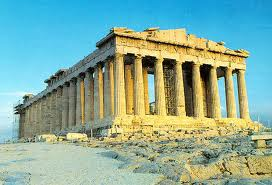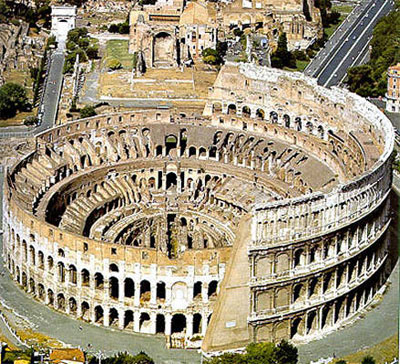Introduction
The prehistoric world starts from the Palaeolithic era all through to the emergence of Islam. Many of the contemporary concepts of art including abstraction and expressionism trace their origin to the primeval world. The history of evolution articulates the basic ties between the government, people’s beliefs, and art.
This paper will examine the characteristics of two forms of ancient art. This will include the Greek and Roman art. It will compare and contrast the “Parthenon (447-438 BCE)” which is a Greek art to the Roman art “The Colosseum 72-80 CE”. The two examples symbolize the characteristics of each culture.
Discussion
One of the most acclaimed Greek Temples is the Parthenon. The temple was built in honour of goddess Athena in 5 BCE and was located in the region of Acropolis of Athena. The sculpture was constructed on the ruins of an older temple. The Parthenon was constructed on three marble platforms and in its architecture is based on three kinds of columns including Doric, Ionic and Corinthian columns. These columns were used in the construction of holy places. In total, the Parthenon had 46 and 19 external and interior columns respectively (Neils, 2005).
The base of the top part of the architecture was made of although it was covered with marble. The entire architecture comprised of white marble and when the sun shone on it, the southern side changed its color to gold with the northern side becoming grey. The sculpture was “provided with more sculptures than any template before or after” (Neils, 2005).It had four parts: the pedometer, metope, frieze and the statue of Athena which comprised of ivory and gold.

The Colosseum, on the other hand, was constructed in 72-80 CE, and is regarded as one of the best sculptures of Roman architecture. It is defined as the “troubling monument to Roman imperial power and cruelty” (Neils, 2005). It is one of the most prominent Roman structures and serves as an archetype for the contemporary colosseum. It was constructed during the reign of emperor Vespasian and rests on a six acre piece of land. As a result of its large size, the Colosseum could accommodate about 50,000 persons (Neils, 2005).

In comparing the Greek sculpture “Parthenon (447-438 BCE)” and the Roman “The Colosseum 72-80 CE”, one sees two distinct pieces of two cultures though with similar values. The function of the Colosseum was quite different from that of the Parthenon. In the primordial era, the sculpture was used for leisure activities such as gladiatorial contests, communal spectacles and animal hunts.
According to Preble and Frank, the Colloseum was built by rulers of the Flavian dynasty for pleasure and recreation (Preble & Frank, 2005). The Parthenon was architecturally built as a place of worshipping Athena who was a Greek goddess at that time and just like the other Greek temples, the building was also used as a treasury.
In contrast to the Parthenon, the Colloseum is elliptical with an entertainment ground at the centre. We can, therefore, conclude that the Parthenon is three dimensional with the Colosseum being two dimensional. The Parthenon had few entrances with the Colosseum having eighty entrances and these were marked by porches. Seventy six entrances were for the audience, three for the elites and one was for the emperor and his assistants.
Although auditoriums were built all through the Roman Empire, none were as large and luxurious like the Colosseum. It was built with concrete floor and its exterior parts were made of brick with a combination of barrel and groin vaults. The idealized figures in the body of the Colosseum were not only meant to be pleasing to look at, but acted as a symbol signifying what the Romans should struggle to be like; it was a like a training contrivance locked in a marble (Preble & Frank, 2005).
Unlike Parthenon, the Colosseum has a rough appearance. The Parthenon has a smooth appearance and this depicts the presence of the goddess. While Colosseum focuses on beauty, Parthenon is cool and is not that pleasing and was made to represent the gentleness of God. The Parthenon has a smooth texture and this stands as remembrance of a naval victory, which was won as a result of worshipping the goddess (Preble & Frank, 2005).
Both sculptures have extensively used the contrapposto stance, idyllic proportions and epic poses. The use of iconography has been used in both, as a sign of inspirational thinking among the audience. Both the Parthenon and Colosseum used the same forms of columns, that is, Doric, Ionic, and Corinthian in their construction. Each arch in the second and third floors of the sculptures had statues at their edges.
Color has been used in the two sculptures as a device and a compositional element. The typical subject of the Colloseum originates from its large size which represents an important person among the citizens such as a general. It portrays an animal reminding the citizens of Rome that have originated from Romulus and Remus who were brought up by a wolf mother in the natural habitat.
While the two pieces of art were both done in the primeval world, they have distinct impressions. The Roman sculpture focuses on leisure while the Greek sculpture is quite practical and focuses on mythology.
Discussion on peer posts
In this paper I will discuss the images selected by Shaina Erwin and LaChandra G. Frails. Since we have all selected “The Colosseum” as the Roman artwork with LaChandria and I also selecting “The Parthenon” as the Greek artwork, then much emphasis will be laid on the Greek artwork “The Doryphoros” selected by Shaina.
The Doryphoros is among the greatest Greek art works of the 5th century. The statue is curved in such a way that it stands alone and is represented by a naked male human body, which symbolizes a standard of proportion and imagery. The bronze artwork, also known as spear bearer is square in shape and stands in a calm contrapposto position.
The left side of the sculpture is curved backwards with a spear shaft on the arms and this creates a sense of motion .The face of the sculpture symbolizes the early classical era and the chest and other abdominal regions appear separated from one another. The face of the sculpture is also generic and lacks emotions and other personal features while the body is smooth, powerfully built, and proportionate (Moon, 1995).
I feel that shaeyna Erwin did not interpret this piece of art well since she did not discuss the significance of lines, texture, shape, value, color, and balance as seen in the sculpture. The artist by carving the statue was trying to portray the new approach of depicting human beings during the classical era. He placed his emphasis on the typical man who in the heroic nudity was represented by a young, healthy body that was naturalistic in strength and pose (Moon, 1995).
The best artwork from the same artist is the Diadoumenos, which represents a slim and elegant athlete. I like the sculpture due to its tectonic organization, balance, and modeling, which symbolize victory.
References
Moon, G. (1995). Polykleitos, the Doryphoros, and tradition. Madison: Univ. of Wisconsin Press.
Neils, J. (2005). The Parthenon: from antiquity to the present. Cambridge: Cambridge University Press.
Preble, D., & Frank, P. (2005). Preble’ Art forms: An Introduction to the Visual Arts. Upper Saddle River: Pearson Publishers.